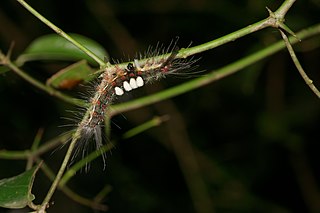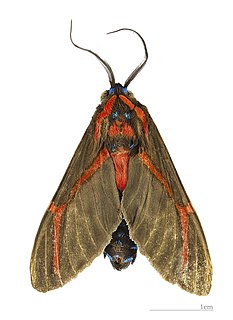
The Pterophoridae or plume moths are a family of Lepidoptera with unusually modified wings. Though they belong to the Apoditrysia like the larger moths and the butterflies, unlike these they are tiny and were formerly included among the assemblage called "microlepidoptera".

The Lymantriinae are a subfamily of moths of the family Erebidae.

The Lasiocampidae are a family of moths also known as eggars, snout moths, or lappet moths. Over 2,000 species occur worldwide, and probably not all have been named or studied.

The Arctiini are a tribe of tiger moths in the family Erebidae.

Nepticulidae is a family of very small moths with a worldwide distribution. They are characterised by eyecaps over the eyes. These pigmy moths or midget moths, as they are commonly known, include the smallest of all living moths, with a wingspan that can be as little as 3 mm in the case of the European pigmy sorrel moth, but more usually 3.5–10 mm. The wings of adult moths are narrow and lanceolate, sometimes with metallic markings, and with the venation very simplified compared to most other moths.
Copromorphidae, the "tropical fruitworm moths" is a family of insects in the lepidopteran order. These moths have broad, rounded forewings, and well-camouflaged scale patterns. Unlike Carposinidae the mouthparts include "labial palps" with the second rather than third segment the longest. With other unusual structural characteristics of the caterpillar and adult, it could represent the sister lineage of all other extant members of this superfamily. The genus Sisyroxena from Madagascar is also notable for its unusual venation and wing scale sockets.

The Phaegopterina are a subtribe of tiger moths in the tribe Arctiini, which is part of the family Erebidae. The subtribe was described by William Forsell Kirby in 1892.
Alpenus is a genus of tiger moths in the family Erebidae. The moths are found in the Afrotropics.
Apeplopoda is a genus of tiger moths in the family Erebidae. The genus was erected by Watson in 1980.
Cheliosea is a genus of tiger moths in the family Erebidae described by Watson in 1980. The moths in the genus are found in Australia.

Chiretolpis is a genus of moths in the family Erebidae.

Halysidota is a genus of moths in the family Erebidae. The genus was erected by Jacob Hübner in 1820.

Himerarctia is a genus of moths in the family Erebidae. The genus was described by Watson in 1975.
Sthenognatha is a genus of tiger moths in the family Erebidae. There is some confusion surrounding the subsequent spelling by Rogenhofer, 1875, as Stenognatha; this spelling was used by many authors prior to 1980, and under ICZN Article 33.3.1 it may need to be preserved, though many authors after 1980 have reverted to Sthenognatha (e.g.).
Viviennea is a genus of moths in the family Erebidae. The genus was described by Watson in 1975.

Micropterigoidea is the superfamily of "mandibulate archaic moths", all placed in the single family Micropterigidae, containing currently about twenty living genera. They are considered the most primitive extant lineage of lepidoptera. The name comes from the Greek for mikros, little and pterux, a wing.
Phiditia is a genus of moths of the family Phiditiidae described by Möschler in 1883.
Melanarctia is a genus of moths in the family Erebidae. The genus was described by Watson in 1975.








